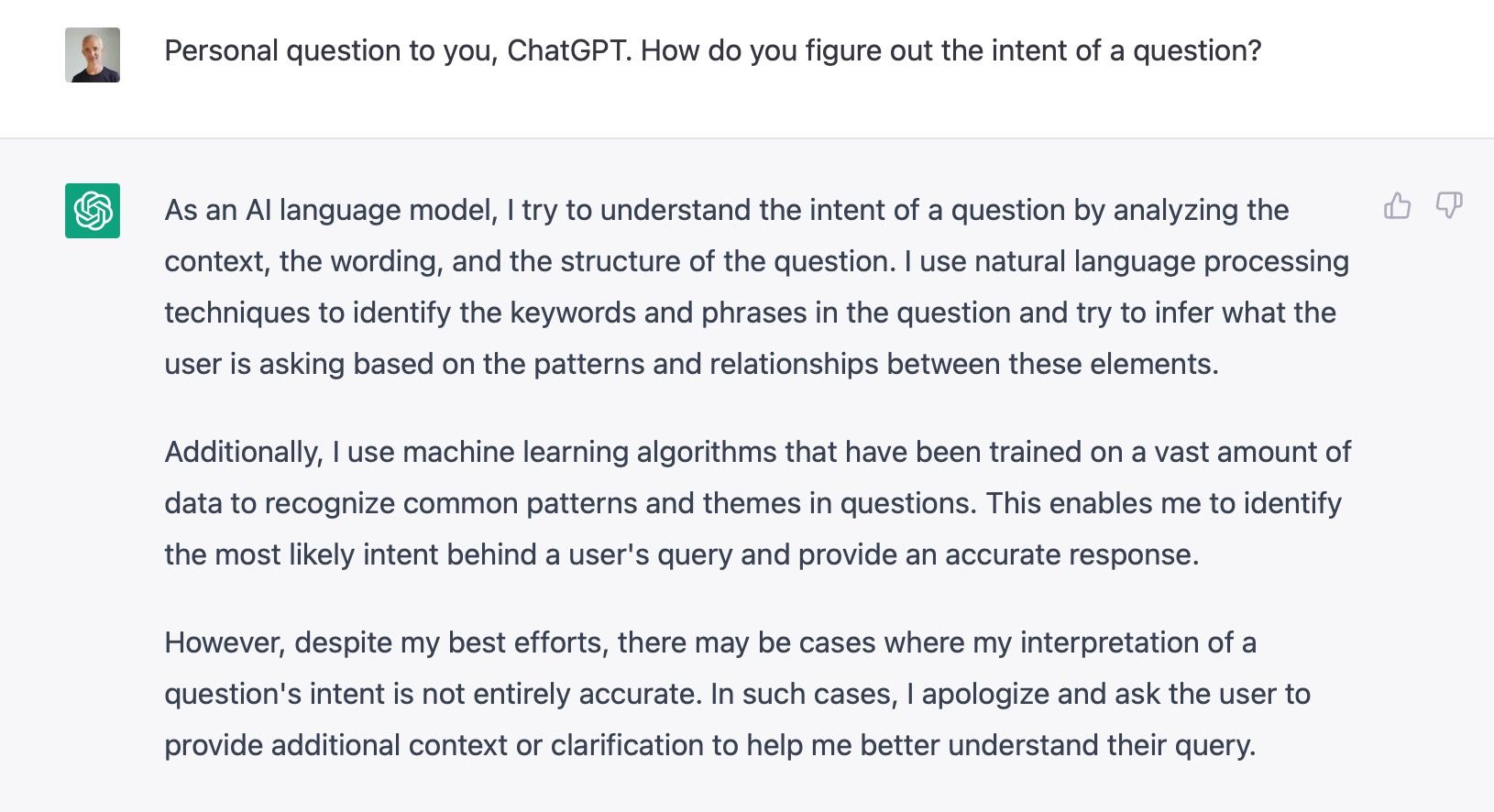How chatbots understand us
A chatbot can understand us by converting a language utterance to intents, entities and by using context. I will explain what an intent is, what entities are and how a chatbot uses context.

In the context of question-answering systems and natural language processing, intent refers to the underlying purpose a user has when asking a question or making a statement. Essentially, intent is the reason why the user is communicating with the system or another person.
For example, a user may ask the question "How is the weather today?" with the intention of getting information about the current weather conditions in their area. Alternatively, a user might ask the question "How do I fix my computer?" with the intention of getting instructions on how to solve a technical problem.
Intention recognition is an important aspect of natural language processing because it allows the system to understand the user's needs and provide an appropriate answer. By identifying the intent of a user's question, a question-answering system can determine what kind of information the user is looking for and provide a relevant answer.

Intents and a language model
An AI language model continuously develops and improves the ability to understand the intent of questions. The training data includes a huge amount of natural language text, allowing patterns and relationships between words and phrases to be recognised.
An AI language model also uses a combination of rule-based systems and machine learning algorithms to analyse the context, structure and wording of a question to determine its intent. This approach allows the system to accurately interpret a wide variety of queries in different fields, including science, technology and everyday life.
However, there are still cases where the intent of a question cannot be accurately determined, especially when the question is ambiguous or the context is unclear. In such cases, users are asked to provide additional context or clarification to help better understand their question.
Examples of intents
There are countless different intentions someone may have when asking a question, as human language is incredibly complex and diverse. Some examples of common intentions when asking questions are:
- Informational: the user is looking for specific information, such as the answer to a question or the explanation of a concept.
- Clarification: the user wants to clarify something they do not understand or are unsure about.
- Instruction: the user is looking for guidance or instructions to perform a particular task or solve a problem.
- Comparison: the user wants to compare different options or scenarios in order to make a decision.
- Opinion: the user seeks the opinion of others on a particular topic or problem.
- Confirmation: the user seeks confirmation or verification of something he thinks is true.
These are just a few examples of the different intentions that may underlie a user's query. As an AI language model, I have been trained to recognise and respond to a wide range of query intentions, and I am constantly learning and adapting to better understand the nuances of human language.
Entities, building blocks for intents
Entities are another important concept in natural language processing that is closely related to intents. While intents represent the general purpose of a user's input, entities refer to specific pieces of information within the input that are relevant to the intent.
Entities are used to extract important information from the user's input to provide a more accurate and useful answer. For example, if the intent is to book a flight, the relevant entities might be the cities of departure and arrival, the date of travel and the number of passengers.
Entities can be considered the building blocks of intents, as they provide the specific details needed to execute the user's request. They can be extracted from the input using techniques such as regular expressions, named entity recognition or machine learning.
In general, entities and intents work together to enable chatbots and language models to understand and respond to user input in a way that is relevant and useful. By extracting the specific information needed to satisfy the user's request, chatbots can provide accurate and personalised responses tailored to the user's needs.
Examples entities
Examples quickly make things clearer. Here are some examples of entities that may be relevant in different contexts:
- Dates and times: Used for scheduling or event-related queries
- Locations: Used for mapping, navigation or searches for local businesses.
- Names: Used for contact management or personalisation.
- Numbers: Used for calculations or quantitative searches.
- Products: Used for e-commerce or inventory management.
- Organisations: Used for business searches or company information.
- Monetary amounts: Used for financial or budget-related searches.
- Quantities: Used for orders or inventory management.
- Dimensions: Used for cooking or construction-related queries.
- URLs or e-mail addresses: Used for web- or e-mail-related searches.
These are just a few examples, and the specific entities that are relevant depend on the context and purpose of the chatbot or language model. Entities can be identified using various techniques, such as regular expressions, named entity recognition or machine learning.
Recent advances in natural language processing
Extracting intents and entities from queries can be challenging because natural language is complex and often ambiguous. Understanding the nuances of language requires not only knowledge of syntax and grammar, but also an understanding of context, idiom and cultural references.
Moreover, the complexity of the task depends on the specific use case and the variety of inputs the chatbot or language model is expected to process. For example, a chatbot designed to provide customer support for a specific product or service may have a narrower range of possible inputs than a general language model that needs to process a wide variety of queries.
However, thanks to advances in natural language processing and machine learning, it is becoming increasingly possible to accurately extract intentions and entities from user input. Using large data sets and advanced algorithms, modern chatbots and language models (such as ChatGPT) can recognise patterns in language and make predictions about the intentions and entities most likely to be present in a given input.
Context of a conversation
Although extracting intentions and entities from user input can be challenging, it is a crucial aspect of developing effective chatbots and language models that can provide accurate and personalised responses to user queries. Here, context, in particular, also plays an important role. In the context of chatbots, context refers to the information or cues available to the system at any given point in a conversation, including previous user input, the current status of the conversation and relevant external data sources.
By using context, chatbots can respond more intelligently and personally to user input. For example, a chatbot designed to help users book flights can use context to remember the user's favourite airline, departure times and other relevant details from previous interactions, and use this information to make more targeted recommendations or offer more efficient booking options.
Context can be modelled in different ways, depending on the specific application and available data sources. Some common approaches include using rule-based systems, machine learning algorithms, or a combination of both, to identify and exploit relevant patterns and features in conversational history and other contextual information.
Summary intents, entities and context
The intents of a question refers to the purpose or meaning of the question, and can be identified and used by chatbots and other natural language processing systems to provide better answers.
Entities are specific objects, concepts or pieces of information that are referenced in a user's input and are relevant to the purpose of the input. Chatbots can use entities to extract specific information or parameters from user input and provide more accurate and personalised responses.
Context is important for chatbots and refers to the information or cues available to the system at any point in a conversation. By using context, chatbots can provide more intelligent and personalised responses.
The process of finding intentions and entities is partly programmed and partly based on machine learning models trained on big data. I will be working on this in the near future and as soon as I have something to show you I will make another article. At least that is the intention 😉



